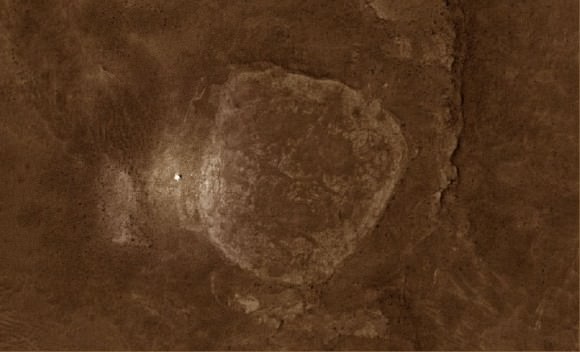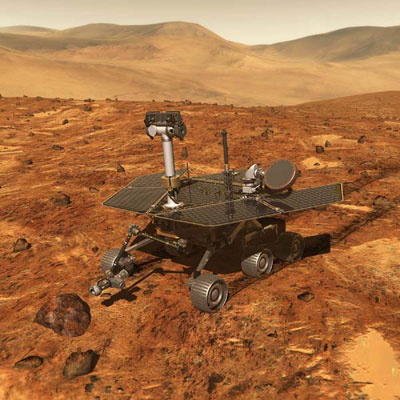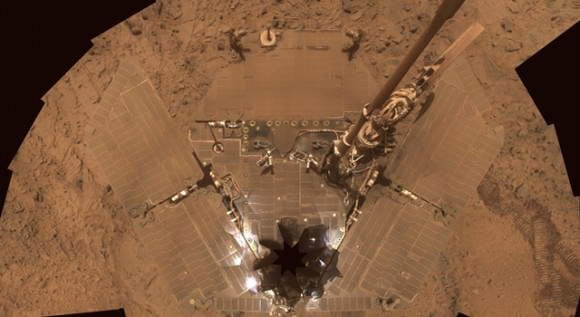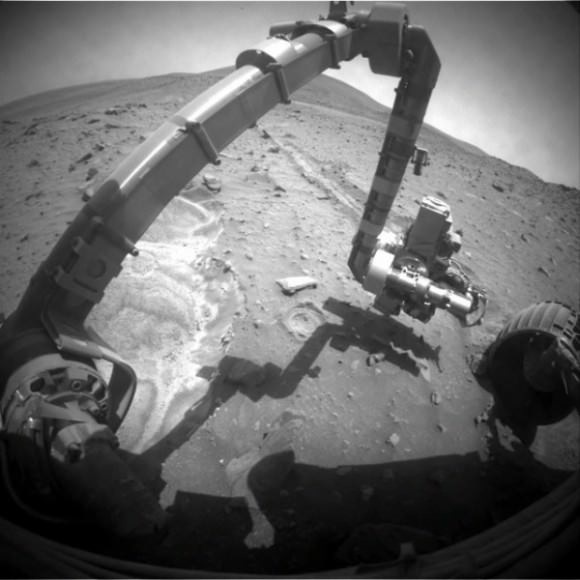[/caption]
In the wee hours of May 25, 2011 the scientists and engineers of the Mars Exploration Rover team will send the last command in attempt to contact the Spirit rover. Over the past year, they have sent over 1,200 commands and haven’t heard anything in reply from the stuck and likely frozen rover. “We have exhausted all the likely scenarios for contacting Spirit, and the likelihood of success is now practically zero,” said John Callas, Project Manager for the Mars Exploration Rover mission. “And at this point, the season is declining and we couldn’t do any of the planned science objectives even if we heard from her now. The Deep Space Network will occasionally listen for Spirit when resources permit, but we have decided not to do anything past the last commands that will done tonight.”

Spirit, the plucky rover that landed on Mars on January 3, 2004, overcame many difficulties and endured waaay past her 90-day warranty. For nearly six years, she traveled long distances, climbed hills — something the rovers weren’t really designed to do — she roved and stopped at interesting rocks along the way, all the while beaming back the information she garnered, enlightening us all about the nature of Mars, past and present.
Spirit became embedded in soft Martian soil in May of 2009 and that was the beginning of the end. The team spent months planning for her extrication, and then months again attempting to drive her out, but they ran out of time and power in the approaching Martian winter. The team was unable to put the rover in a favorable position to catch rays of sunlight on her solar panels, and after another freezing, grueling winter, Spirit has now likely succumbed to the harsh environment on Mars.
“We drove it, literally, until its wheels came off and at the beginning of the mission, we never expected that would be the way this project would end up,” said Dave Lavery, MER program director at NASA Headquarters.
The last commands will be sent early on May 25, 0700 UTC, which is just after midnight at JPL in Pasadena, California.
So, this is it. This is end of the Spirit rover mission.
“We always knew we would get to this point,” Callas said during a teleconference with the press, “and really, that’s what we wanted to do, to utilize these rovers as much as possible and wear them out. We are here today because we really wore Spirit out. If on sol 90 (the 90th Martian day of the mission) someone would have said this was going to last another 6 years, we just wouldn’t have believed it.”

Asked what Spirit’s lasting legacy would be, Callas told Universe Today, “In addition to the great exploration and scientific discoveries, I think the great intangible that goes with Spirit is that she has made Mars a familiar place for us. It is no longer a mysterious location. For six years we’ve had people who go to work on Mars every day, via the rovers.”
The original plan was to try and contact Spirit once a week through the end of 2011, but the team has come to realize that the probability of success was practically zero and they would be wasting valuable resources, both human time and listening resources from the DSN. So the decision was made to end the attempts to contact Spirit.

One of the challenges that Spirit faced is that it always had dust on the solar arrays, Callas said, even during the first winter on the Columbia Hills. After a timely dust cleaning event by a dust devil, the team was able tilt Spirit to gather sunshine and she survived. The second winter she achieved a 10% tilt and survived; the third winter, the team was able to find a 30% tilt – again she survived. But the 4th winter, there just wasn’t the right geography in the sand pits of Troy that would enable Spirit to survive after it became embedded.
What is the mood of the rover team? “We all are taking realistic look, as this mission was originally supposed to last only 90 sols, and we thought if we were extraordinarily lucky we’d get twice that much time and that the first Martian winter would be the end of the mission” said Lavery. “Realistically, in every possible definition of the word, we looking at this as a massive success in terms of longevity and the massive science return we got out of the project. As this particular chapter of Spirit’s mission comes to a close, this is very much a celebration of the accomplishments of the rover and the success it has had, and looking forward to the next steps of Mars exploration.”
Lavery added that the teams are not looking at this as a funeral, but more like an Irish wake. “I’m sure we’ll be telling stories of when Spirit was a wee little rover,” he said. There will be a science team meeting in July and they will use that opportunity to bring together all who were involved in development and science planning to come together and have some sort of event at that time.
“They are cutest darn things out in the solar system,” Callas said. “Yes, we are attached to these beautiful, accomplished little proxies out on the surface of Mars. We have sadness that we have to say goodbye to Spirit, but we have to remember the great accomplishments and the blessings we’ve received for having this rover operate for all this time, for over six years.”

Spirit made many discoveries – finding carbonates which told scientists much about the past habitability of Mars and that it likely had a thicker atmosphere at one point. Then, even failure brought discovery, as the malfunction of the right front wheel in 2004 meant the team had to relearn to drive the rover, driving it backwards, dragging the wheel behind. This churned up the top soil and revealed what was under the surface: amorphous silica, which is evidence for an ancient hydrothermal system on Mars, which means not only water but an energy source that could have been driving a type of ecosystem in one particular location on Mars.
“There’s an enormous amount that can and still will be written about Spirit and the discoveries she’s made. The science team will be writing papers for a long while,” said Lavery. “But there’s also the inspiration that the rover provided to the team and really to the entire country that we were able to put together a project that went to another planet and survived well past its designed lifetime. The sense of wonder and sense of accomplishments go well beyond the mission itself.”
Yes, we knew this day was coming. Spirit roved her way into our hearts and into the science books. She will not be forgotten.



I guess this means NASA needs to look for certain qualifications in Mars astronauts…
http://www.yourjeep.com/wp-content/uploads/2010/04/jeep-winch.jpg
I hope that the new lander is better able to turn the solar collectors for optimum power during winters.
The new lander is not running on solar power, so that won’t be an issue
The lander platform (aeroshell & sky crane) will to the best of my knowledge be battery powered.
The Curiosity rover will be powered by a radioisotope thermoelectric generator.
Thank you! I did a short translation + additions about thw twin rover opportunity (Which is about to pass 30km – amazing!)
Gadi.
Good Job little Rover 🙂
The Rover design team is to be commended. Maybe they can to to work for the car companies.
R.I.P., Spirit. Humanity will always be in your debt.
Good night, Spirit. You’ve done well.
http://xkcd.com/695/
RIP…
Thank you brave Spirit, for taking me along on your journey of exploration on Mars.
6 years instead of 90 days isn’t so bad, it’s oustanding !
The rover team did a good job.